What kind of bird have you seen in Wisconsin that is blue in color? There are over a dozen species of blue birds in the state known for its Packers and tasty cheese, so your odds of seeing one are good! Grab some cheese curds and get ready to look at nine gorgeous blue birds found in this midwestern state!
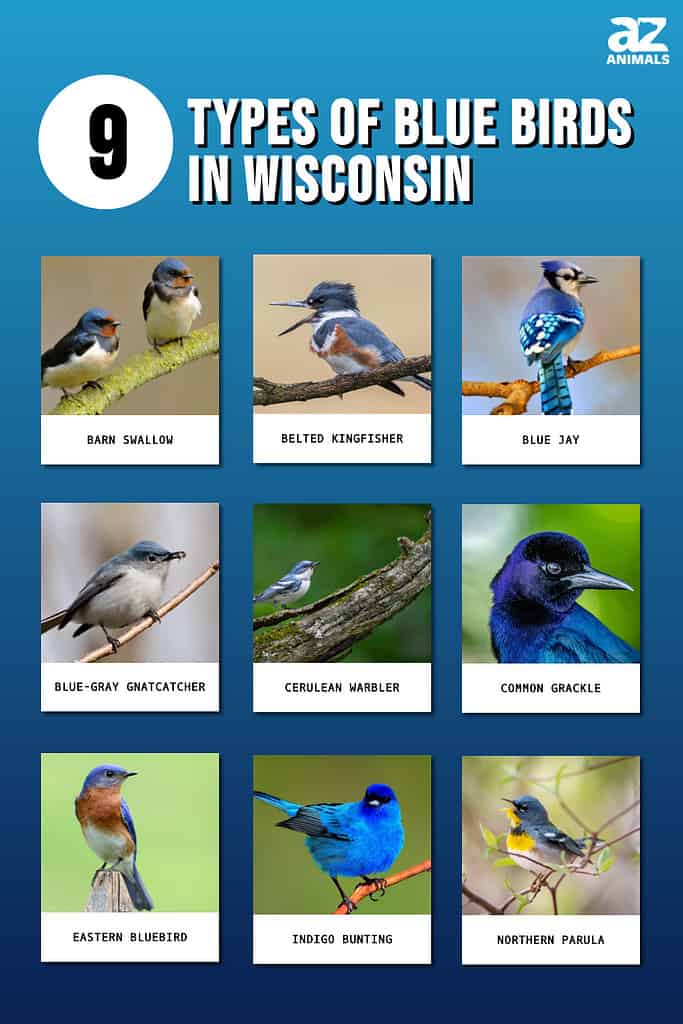
Barn Swallow
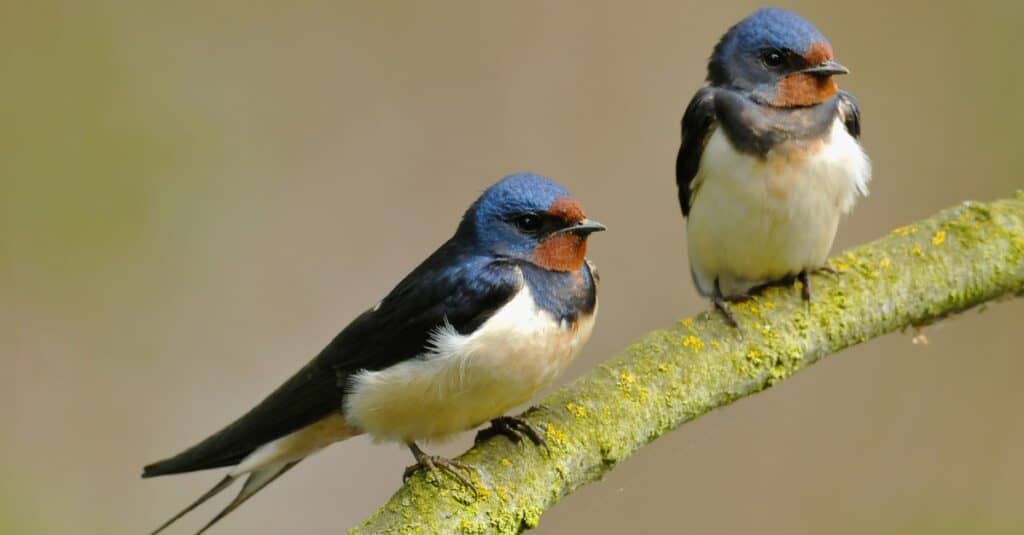
Two Barn Swallows (
Hirundo rustica) sitting on a branch.
©CezaryKorkosz/Shutterstock.com
The underparts of barn swallows are rufous to golden, and they have a brilliant blue back, tail, and wings. The cardamom-colored forehead and neck juxtapose with the blue crown and face. Except when flying, it can be challenging to discern white specks under the tail. Compared to females, males have more vivid colors.
The sparrow-sized Barn Swallow has broad shoulders that curve toward long, pointed wings, a somewhat flattened head, no apparent neck, and a cone-shaped appearance when seated. Their tail is much longer than their wingtips. Barn Swallows also have deep forks thanks to their lengthy outer feathers.
Barn swallows forage while flying, catching insects 100 feet above the water or the earth. They can do swift, tight spins, and dips and soar with fluent wingbeats in spurts of a direct flight, seldom gliding. Barn swallows may associate with other swallow species in mixed-feeding flocks when the aquatic insect eggs hatch.
Birds in Wisconsin: Belted Kingfisher
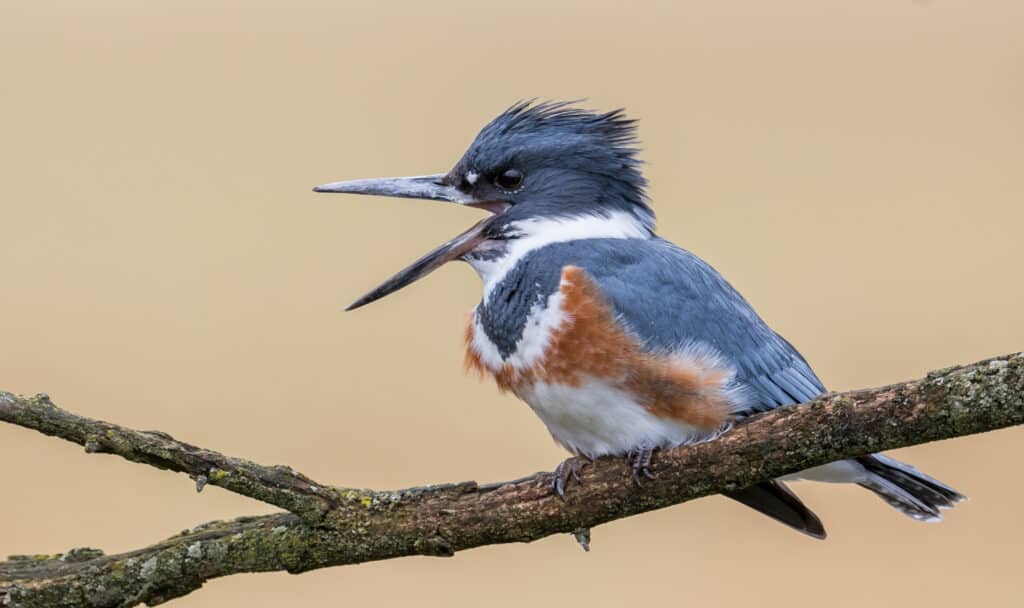
This dagger-billed, straggly bird is typically seen adjacent to a lake or stream or lingering over the water before diving headfirst to capture a fish.
©Harry Collins Photography/Shutterstock.com
Belted Kingfishers are common in Wisconsin. They love to chatter and rumble their song along rivers or lakes. This dagger-billed, straggly bird is typically seen adjacent to a lake or stream or lingering over the water before diving headfirst to capture a fish.
This bird is frequently heard before it is seen. It is difficult to mistake this species for any other bird that inhabits the same area due to its unique appearance. It has a huge head and neat-looking blue-and-white feathers. Belted Kingfishers build tunnels for their nests in sandy banks.
Kingfishers have stumpy legs and small feet, yet their long, flat toe and pointy, sharp claws are designed to speed up burrowing. The tunnels they build slope uphill from the entrance and are one to eight feet long. This is likely done to prevent flooding of the nest area where the female lays her eggs.
Blue Jay
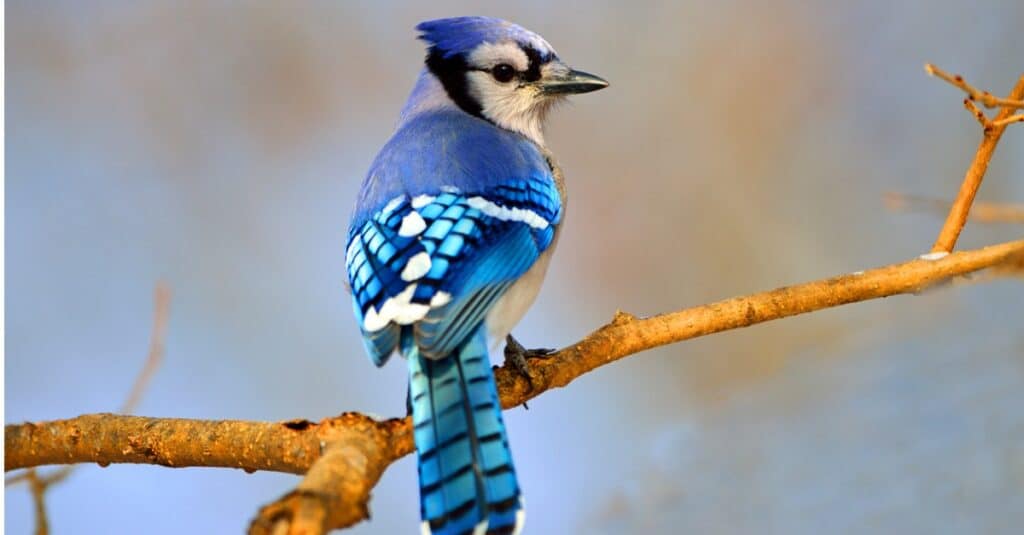
Beech and oak trees are the most common places where blue jays forage.
©iStock.com/BrianEKushner
With their common size, flamboyant crest, blue, white, and black plumage, and loud calls, this huge songbird is well-known to many people in America’s Dairyland. Blue Jays are recognized for their intelligence, complex social systems, and close-knit families.
It’s thought that their fondness of acorns helped oak trees proliferate during the most recent glacial period. The movement of thousands of Blue Jays in flocks all along the Great Lakes and Atlantic coasts is still mostly unknown.
Some remain active all winter long across their entire territory. Although young jays might migrate more frequently than adults, many adults still choose to do so. Some solitary jays move south one year, spend the following winter up north, and then move south once more the following year. Nobody has determined why they move at the times they do.
Birds in Wisconsin: Blue-Gray Gnatcatcher
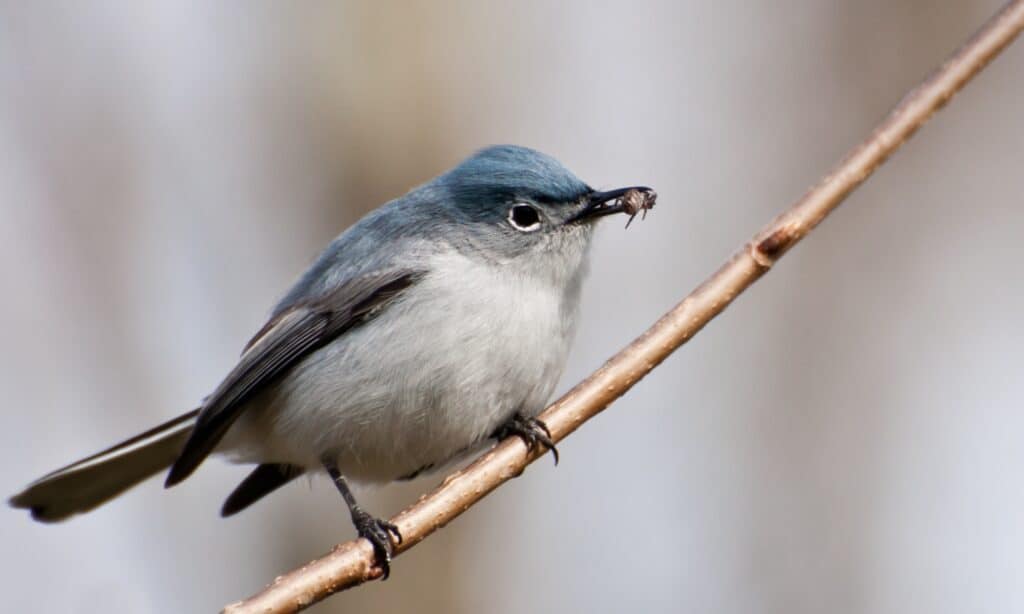
A close-up of a Blue-gray Gnatcatcher. Its long tail feathers contain both black and white feathers.
©iStock.com/JasonOndreicka
The Blue-gray Gnatcatcher is a small, long-tailed bird that inhabits broadleaf woods and scrublands. It can be identified by its persistent, mellow calls and continual movement. While hunting for bugs and spiders, it leaps and slithers through the outer heavy foliage.
This gleaming blue-gray bird moves with a prominent flick of its white-edged tail, frightening insects and pursuing them. Pairs construct tidy, little nests that resemble tree knots on top of branches using spiderwebs and lichens.
The only migratory gnatcatcher species is the Blue-gray Gnatcatcher, found in the world’s northernmost regions. Its genus is primarily found in Central and South America.
Cerulean Warbler
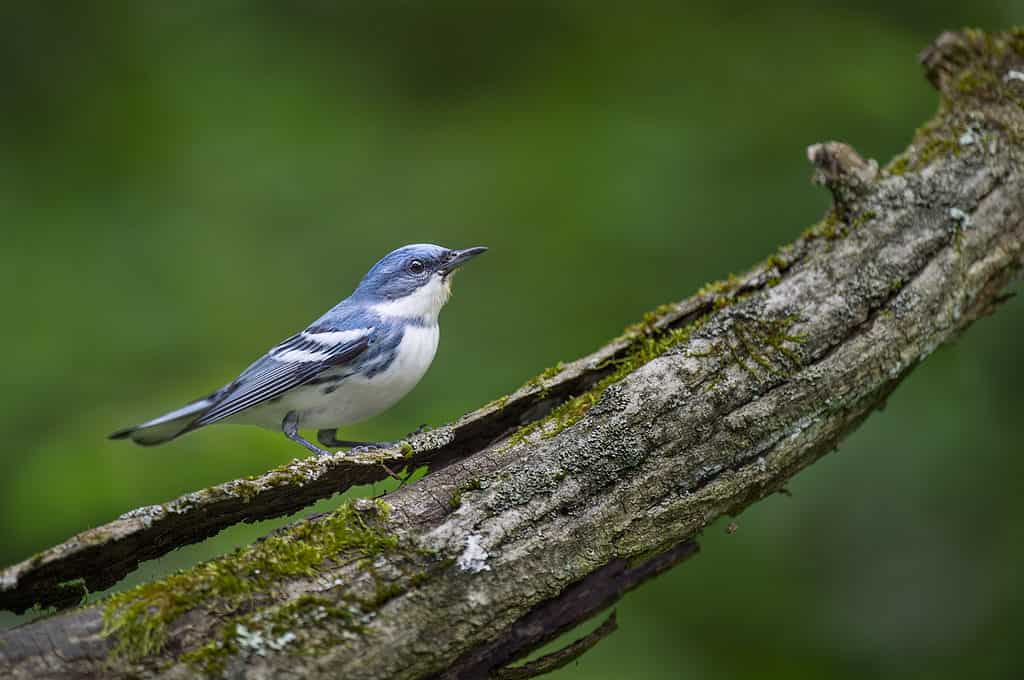
A bright blue and white Cerulean Warbler perched on a textured log.
©iStock.com/ps50ace
Small and compact, the Cerulean Warbler frequently perches horizontally. It has a smaller, rounder bill and a shorter tail compared to other warblers, like the magnolia warbler. Males have a sky-blue upper body with two white wing bars, black streaking down their backs, a narrow blue band on the neck, and blue streaks on either side of their white abdomen.
Females have touches of yellow and bluish-green. They lack the males’ side streaks and neck bands. Additionally, females have two white wing bars and a whitish eyebrow.
In the dense canopy, these birds will bounce along the branches. They frequently gather food close to canopy gaps. Males sing an upbeat, buzzing melody that locals enjoy.
Birds in Wisconsin: Common Grackle
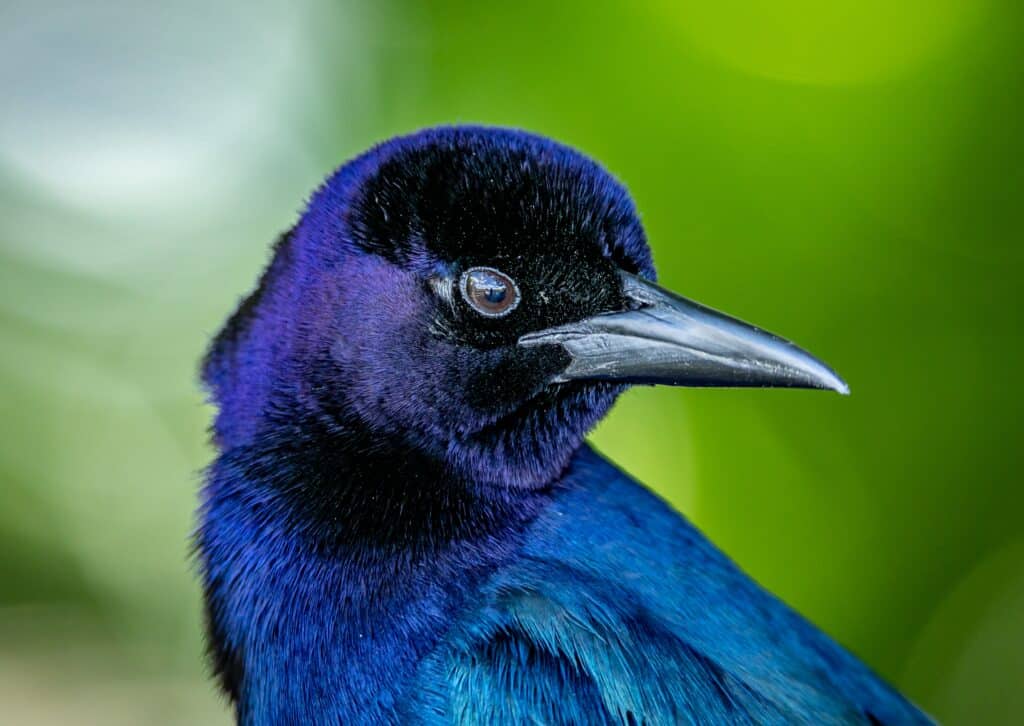
The common grackle forages on the ground, in shallow water, or shrubs and trees.
©Holly S. Cannon/Shutterstock.com
Blackbirds, known as common grackles, have a somewhat elongated appearance. They have larger, more tapered bills, shiny blue, iridescent bodies, and longer tails than regular blackbirds. Long-legged grackles can move around fields and lawns or congregate in noisy flocks high in trees, usually evergreens.
They consume a variety of crops, most notably corn, as well as almost everything else, even trash. Their long tails dangle behind them as they fly, occasionally folded into a narrow V-shape in the center. Grackles are sometimes mistaken for scarecrows in cornfields.
They consume both mature corn and corn sprouts, and because they frequently forage in large flocks, their economic impact is substantial. By spraying a bad-tasting chemical on corn sprouts or killing grackles at their roosts, some farmers have attempted to lessen their effects.
Eastern Bluebird

Eastern Bluebirds can be found in semi-open areas with sporadic trees, farmland, and other habitat types.
©iStock.com/SteveByland
In the summertime, most country roads in eastern North America will reveal a few Eastern Bluebirds perched on electrical cables or atop nest boxes. They usually chirp out in shaky song or suddenly plunge to the ground in pursuit of an insect.
They typically will be found in Wisconsin during the breeding season. Male Eastern Bluebirds are magnificent creatures with vivid royal blue on their heads and backs and cozy red-brown bellies. The grayer females have an attractive appearance thanks to the blue tinges on their wings and tail.
These birds eat bugs, berries, and wild fruit. Eastern Bluebirds must avoid large prey like shrews, newts, snakes, lizards, and tree frogs.
Indigo Bunting
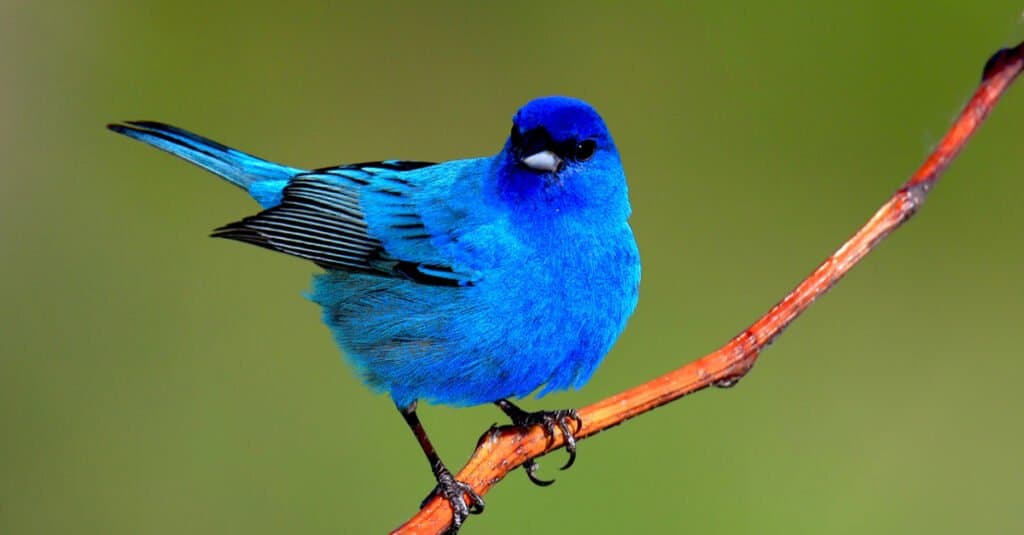
An Indigo Bunting.
©John L. Absher/Shutterstock.com
Indigo Buntings are little stocky birds with short tails and small, wide, conical bills. The birds look chubby and have short, rounded tails when flying. A mating male, Indigo Bunting has a lustrous, silver-gray bill and is entirely blue, with a somewhat richer blue on his head.
Most females are brown, with a pale throat, a few light streaks on the breast, and occasionally a hint of blue on the wings, tail, or rear. Immature males have blue and brown patches on them.
All summer, male Indigo Buntings chirp from power lines, bushes, and treetops. This species, which consumes bugs, seeds, and berries, is drawn to gardens full of thistle or nyjer seed. These birds often move their tails from side to side while resting.
Northern Parula
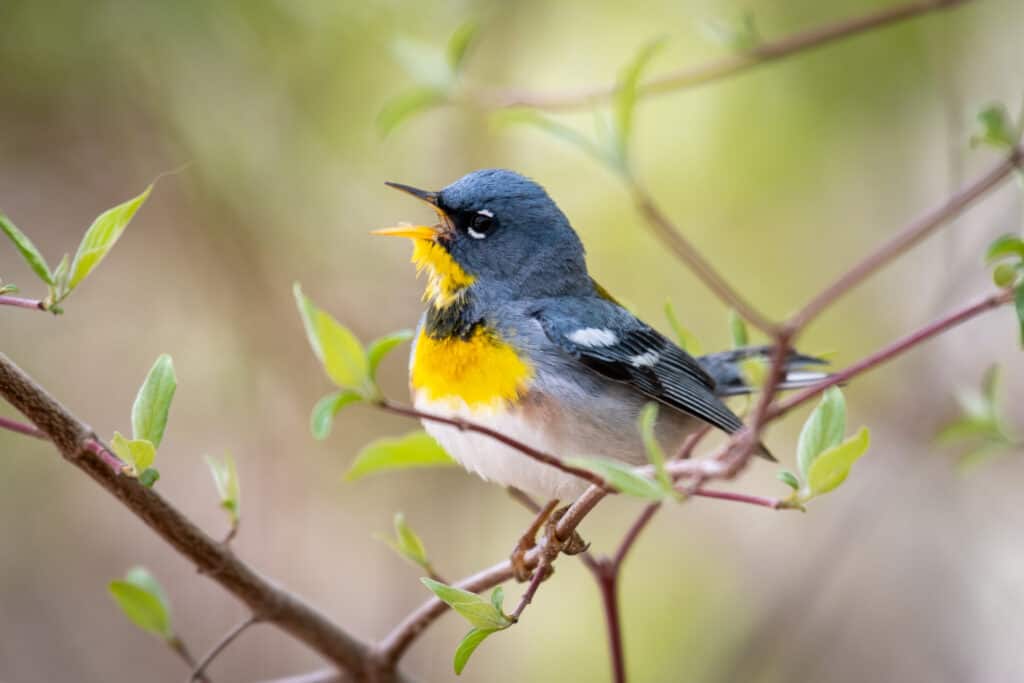
The northern parula is a small warbler that lives in forest canopies during summer and tropical plantations in the winter.
©Nattapong Assalee/Shutterstock.com
Northern Parulas have slender, pointed bills and short tails. They resemble kinglets in size and are chubby tiny warblers. They have a yellow-green spot on their backs and two white bars on their wings. These features of the adult male add to its overall blue-gray coloration.
The male’s bright yellow neck and breast are divided by a chestnut stripe. Adult females often lack the male’s chest band and are slightly paler. Both sexes have white crescents in their eyes. Young birds lack the brown breast band and are lighter than adults.
9 Types Of Blue Birds In Wisconsin
| Number | Blue Bird |
|---|---|
| 1 | Barn Swallow |
| 2 | Belted Kingfisher |
| 3 | Blue Jay |
| 4 | Blue-Gray Gnatcatcher |
| 5 | Cerulean Warbler |
| 6 | Common Grackle |
| 7 | Eastern Bluebird |
| 8 | Indigo Bunting |
| 9 | Northern Parula |
The photo featured at the top of this post is © Rafal Szozda/Shutterstock.com
Thank you for reading! Have some feedback for us? Contact the AZ Animals editorial team.







